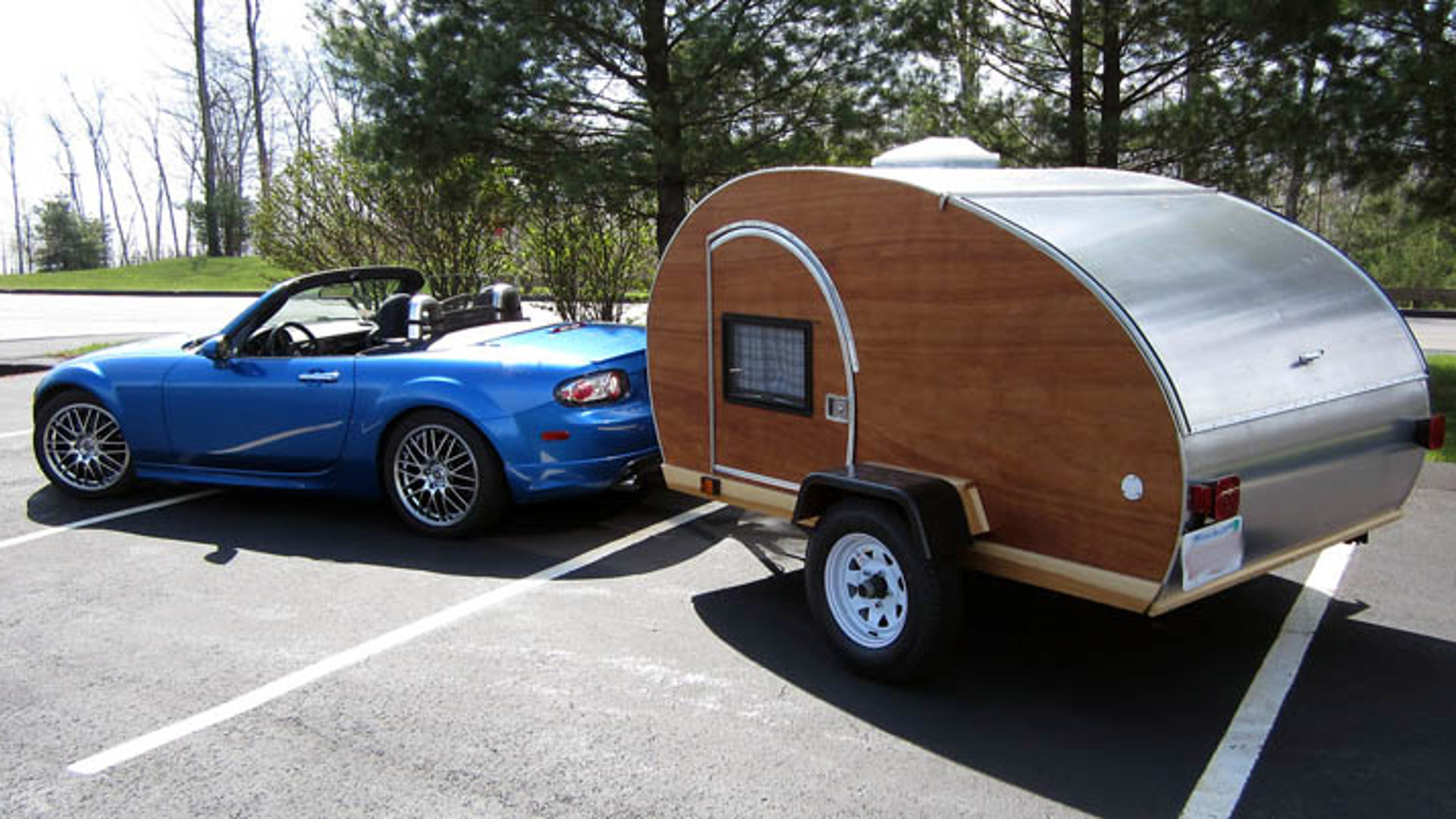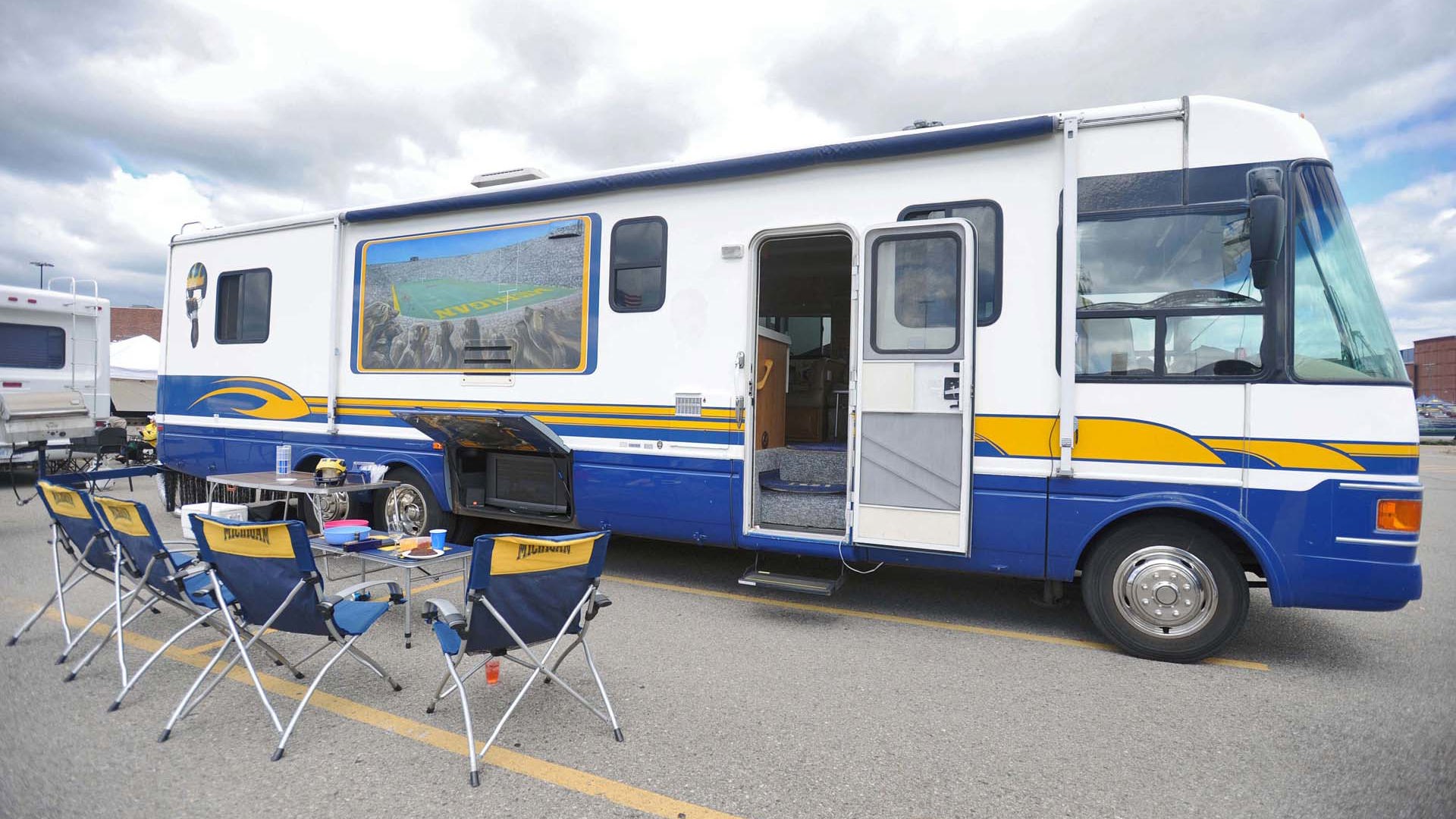Searching for the exact, perfect RV for your family, you can get lost in a maze of options. There are dozens of styles and endless variations of floorplans. Slide-outs, bunks, and any piece of furniture that could conceivably convert into a bed all maximize the living space. Sizes range from miniscule to mammoth, and so do prices.
But the first decision when making what is quite possibly the third-largest purchase of your life, after your house and car, is: engine in or engine out?
In other words, should you buy a motorhome, which is a vehicle with living space built in, or a trailer, which is just the living space on wheels and requires a separate vehicle to tow it? They each have their benefits and drawbacks, and each has several subtypes which vary drastically in size, sleeping capacity, ease of handling, and ongoing cost of ownership.
With the engine built in, motorhomes do carry additional maintenance and insurance costs (except the class B; more on that below), but you also don’t need to worry about weight if your vehicle isn’t powerful enough for the size of RV you want. If you don’t have experience towing, motorhomes are easier to handle than equivalent-length trailers, though the larger models can be difficult to turn and park, and all RVs have some sway – and many have enough height for low bridges to be an issue.
You also don’t have the option to detach and use your vehicle at your destination with a motorhome, so if you want mobility, you’ll still need to tow your car along. The best part of a motorhome, though, is the all-in-one convenience. Less time setting up means more time enjoying your destination.
If you decide on a trailer, you are going to need a vehicle to tow it. There are two routes for this: choose a trailer based on what your current vehicle can handle, or buy a suitable truck at the same time (this option can still be cheaper than some motorhomes, and some RV dealers even offer packages).
If you have a vehicle you’re planning on using, you need to know its GVWR (gross vehicle weight rating, which includes the weight of the vehicle, the trailer, its contents and yes, the passengers). This is going to determine how much weight you can pull. I cannot stress enough that you should never exceed your vehicle’s towing capacity. You could do serious damage to your engine. There is an RV out there for every engine – including motorcycles – but if you’re planning on sleeping six or more, you are looking at a truck, possibly one with heavy-duty specs.
That said, having a separate vehicle means you can unhitch and go at any time. Insurance and maintenance tend to be lower, and there is a greater range of options than motorhomes.
And boy are there options. Let’s look at some of the general classes of both types of RV.

Class A Motorhome
The largest and often the most expensive class, this is the king of RVs. More space, more storage, more slide-outs, more amenities. Also more money, more fuel, more trouble manoeuvring, and more RV to store when not in use. These behemoths can have all the luxuries of home, like heated floors, ice makers and laundry facilities – even a “basement" for extended storage.
Sleeps: Up to 10
Length: Up to 45’
Price: High to “I Could Buy a House in Vancouver for This"
Other considerations: Expect very high fuel expenses and a good fight for a space if you arrive late to the campground.
Class B Motorhome (Camper Vans)

They may not look like it but these raised-roof camper vans, which are commonly built on commercial van chassis like the Sprinter or Transit, can be equipped with tiny kitchens and bathrooms – even holding tanks for water and waste. Driving and storage are a breeze, but they only sleep two and they can cost as much as a larger Class C. They make up for it in the long run with cheaper maintenance, fuel, and insurance expenses. No need to tow along your car either; most camper vans fit in a standard parking spot, and minimal setup leaves you free to come and go from the campground.
Sleeps: 2. Even if the manufacturer claims 4, it’s 2.
Length: Up to 20’
Price: Mid, which is high for the amount of space you get.
Other considerations: Easy to drive, easy to store, easy to maintain. Just make sure you really like whomever you bring along.
Class C Motorhome

The child of a class A and a camper van, this motorhome comes in a variety of lengths and styles. More manoeuvrable than the class A but roomier than the class B, one of the identifying features is a space over the cab for sleeping, entertainment or storage. Being built on a cargo van chassis, they are easier to service than a class A, and the smaller size is a nice compromise between living space and manoeuvrability–and it’s much easier to snag a spot in a crowded campground.
Sleeps: 4 to 8
Length: 22’ to 33’
Price: Mid to high
Other considerations: If you’re new to RVs but know you want a motorhome, a class C is a great place to start.
Travel Trailer

The most popular class of trailers, travel trailers come in every imaginable configuration. They range from 9’ to 40’, but the larger you go, the stronger your vehicle needs to be, and the more difficult they are to drive with. Braking, turning, and backing up are all adventures with a trailer – even simply being passed on the highway by a big truck can be nerve-wracking when your trailer starts bucking in the wind tunnel. For versatility however, they can’t be beat.
Sleeps: Up to 10
Length: As small as 9’. Mid-size ranges from 18’ to 25’, and can be towed with a pickup or SUV. Larger trailers are 25’ to 40’ and require some more serious towing power. At their smallest, they can be towed by a 6-cylinder sedan.
Price: Low to high
Other considerations: A broad range of options keeps this kind of trailer at peak popularity. If you’ve never towed a trailer, you may want to find a big empty parking lot to practice in before hitting the road.
Fifth Wheel Trailer

Similar to travel trailers, the main difference with a fifth wheel is how it’s towed. Rather than hooking up to a traditional hitch they latch on to a fifth wheel, similar to the kind big rigs use to haul freight trailers, that is installed in the bed of the truck. Having the hitch over the truck bed does two things: it increases the total length, and therefore the amount of living space, and it stabilizes the drive considerably. There is less sway and a lower risk of jack-knifing, making them the safest choice for towing. The raised forward section gives this trailer a homey, split-level feel, but you might spend a bit longer setting up when you reach your site.
Sleeps: Up to 10
Length: Up to 45’
Price: Mid to high
Other considerations: You’re going to need a one- or two-ton truck for all but the smallest fifth wheels, but if you’re serious about RV-ing, it’s well worth the investment. This is the preferred trailer of many year-round RV enthusiasts.
Toy Hauler (Sports Utility RV)
A typical travel trailer or fifth wheel with the addition of a garage-like storage area so you can take your toys along. Great for ATVs, motorcycles or just more storage, a toy hauler adds a lot of versatility to your vacation.
Sleeps: Up to 10
Length: Up to 45’
Price: Mid to high
Other considerations: Don’t forget to include your ATVs in the total loaded weight of your RV.
Pop-Up Camper (Tent Trailer)

Just because you don’t drive a giant truck doesn’t mean a trailer is beyond your grasp. Tent trailers, with their pop-up sleeping areas, are small and lightweight. The folding ends make them smaller to tow and store. Some models have a pop-up roof as well, making them even more compact, but they also come in hard-sided varieties, allowing for more cupboard space and counter height. They usually include a kitchen, but don’t always have bathrooms.
Sleeps: 4 to 8
Length: 8’ to 16’ – and double that when the ends are deployed.
Price: Low
Other considerations: Lightweight and easily towed by smaller vehicles.
Pop-Up Hybrid (Expandable)
These are essentially travel trailers made more compact with the addition of folding sleeping areas à la tent trailer. This makes them smaller to tow and store without compromising on living space. Bathroom included!
Sleeps: Up to 8
Length: 19’ to 30’
Price: Low to mid
Other considerations: Not quite as light as a tent trailer, but smaller ones are towable with a 6-cylinder family car or SUV.
Truck Camper

Forget towing altogether and turtle your way into summer adventure with a camper that slides right into your truck’s bed. They’re as easy to drive and store as a camper van, but much more economical since you provide the wheels. Despite the small appearance they can be quite roomy, include both kitchen and bathroom, and may even be equipped with slide-outs. Plus they can go wherever your truck can, making them popular choices for outdoorsmen.
Sleeps: 2 to 6
Length: 8’ to 20’
Price: Low to mid
Other considerations: If a toy hauler is more than you need, a truck camper will free up your hitch to tow your toys.
Teardrop Trailer and Motorcycle Trailers

These little two-wheeled trailers are little more than sleeping space, but they are the lightest RVs available, under 1,000 lb. The larger teardrops might have a small galley kitchen and with luck some variety of bathroom facilities. Motorcycle trailers, on the other hand, are hardly larger than the bikes towing them. Some are pop-up style (part camper, part tent) but others are miniature teardrop style with little room for anything but a bed. They might be adorably tiny, but an RV is all about freedom to travel.
Sleeps: 1 to 2
Length: 8’ to 10’
Price: Low
Other considerations: There aren’t as many options for small cars and bikes, but trailers in this size range are often custom build or DIY kits, which opens up all kinds of possibilities.
Now that you know the options, you can narrow your choice down with these considerations:
• Your budget (both for the purchase and ongoing expenses like insurance, maintenance, fuel, and storage).
• Your vehicle’s towing capacity (or your willingness to trade in for a larger truck/choose a motorhome).
• How many beds you need and of what kind (your kids can climb into an overhead bunk, your elderly parents not so much).
• Whether you want to buy new or used.
• How much space you need. Keep in mind that unless you have the property to store it yourself (and local bylaws allow you to do so), you will be paying for every inch your RV takes up. So… how much space do you need?
Once you’ve answered these questions, the style of RV that’s right for you will start to become clear. The next step is wading into the endless floorplans and slide-out options... but that is an abyss from which no one returns.
Whether you’re ready to make the most of the remaining summer weeks or preparing for future adventures, going into such a major purchase with a good idea of the style of RV that’s right for you will keep you focused and on track. After all, a shiny outdoor kitchen is no good if you can’t tow it.

